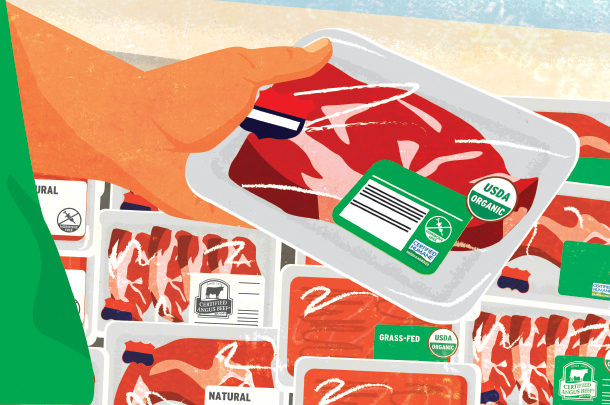So often, we hear about what the average person on the street wants in regard to beef. Hormone-free, organic, grass-fed, natural – just to name a few. But most of these often-well-meaning people have never been on a farm or ranch. Should the cow-calf producer, feedlot or finishing operator ignore these sometimes-arbitrary desires and demands, modify their business to satisfy them or slide safely into the middle ground? And how does making a living become a part of the answer?
Who’s at the wheel?
The consumer is driving and steering this car, says Andrew Griffith, associate professor and livestock economist with the University of Tennessee. But a few answers are needed to determine just where the road map is leading.
“The amount of say they have will have to do with how flexible their pocketbook is. If they are willing to pay for all grass-fed, antibiotic- or hormone-free, somebody will try to produce it. We’ve seen that already.”
He says studies have shown a willingness of interested consumers to cover small premiums over conventional programs for niche markets such as organic or all-natural, but the amount matches the extent of leverage they hold.
“What price will they pay for alternative beef production? They can have a lot of sway if they don’t hold back, but if they’re not willing to write the check, it’ll be hard to push a more restricted system unless it’s through legislation.”
Feedlot owners won’t keep on feeding cattle a specific way if they can’t afford to stay in business, and the cow-calf producer won’t continue if they’re losing money.
“The slippery slope is: Do we let people’s voices dictate what happens versus what their pocketbooks and bank account are willing to pay for? In America, sometimes we get confused and let voices influence over what capitalism dictates.”
Where’s the efficiency coming from?
With the world’s population continuously expanding, livestock industries are constantly stepping up to the plate to meet demands. Griffith says North America is working hard to drive efficiencies, sometimes with revamped systems and sometimes with the introduction of technology.
“We know most cow-calf production is pasture-based. And we know that’s the best way to feed a cow. We also realize if we’re going to produce more, we could put them into a confined situation with a higher-energy, higher-protein, more nutrient-dense ration to quickly ramp up production.”
This becomes possible by continuously implementing greater efficiencies in agricultural practices. He encourages hesitant farmers and ranchers to take advantage of these expanded opportunities, or it will become more and more expensive for shoppers to consume beef.
“We’re working hard to keep it relatively inexpensive for them. But if we’re forced to move to something like an all-pasture-based system, suddenly we can’t produce enough.”
Ben Eborn, extension ag economist, department of agricultural economics and rural sociology at the University of Idaho, is optimistic about the future of beef demand but acknowledges producers will shift at least a portion of their programs to match pressure.
“The consumer is the key, and whatever they want, whether it be organic or all-natural or something else, it will continue to grow. There are already premiums in the market for those products, and they’ve been growing pretty steady over the last number of years. But I don’t think by any means these will overtake our commercial industry.”
He envisions the world’s demand for more beef continuing to grow as incomes rise. With improving conditions throughout developing nations, he believes it will gain in popularity over other protein sources such as chicken.
Constant innovation of technology and advances in genetics pushing efficiencies will be a driving force.
“It’s an ongoing treadmill of innovation in the industry,” said Eborn. “We get better and better at delivering more beef per acre. It’s a never-ending trajectory.”
How can advancements be balanced with trust?
For Eborn, it’s a catch-22, as beef production will need the assistance of technology and innovation but he acknowledges the average person doesn’t always trust what the industry is doing.
“That’s one of the biggest battles I think the industry has. The larger the feedlots and processing plants are, the less consumer-friendly they appear. It’s a matter of trust.”
He says not everyone needs to be at the forefront of improvement and advancement, since those at the top propel the efforts.
“If we look at the carcass quality since 1980, for example, it’s gotten better and better. Higher value and grades, plus increased yields with greater proficiency. And because the top producers are innovative and on the cusp of genetic technology, it trickles down to all those buying seedstock.”
A further example of the push for increased efficiency is the growing promotion of hormones for calves, stockers and finishing cattle, says Phillip Lancaster, research assistant professor in the Beef Cattle Institute, College of Veterinary Medicine at Kansas State University.
“While companies are still using most of the same hormone compounds, newer implants are focused more on helping management. Products are using extended releases so, instead of reimplanting every 70 or 100 days, these have 200-day payouts. Animals can be implanted at the beginning of a feedlot cycle or grazing season and go throughout the summer or finishing period.”
It’s a simple illustration of how health and technology is constantly developing to meet demands and satisfy concerns over animal welfare.
The industry must continue to provide high-quality beef for a reasonable price while technology assists profitability, says Lancaster.
“The consumer has to keep buying beef, but the producer needs to keep making money. If either one of those things completely stops, then we don’t have an industry. The goal is finding the optimum, middle or common ground.”
The average shopper in the grocery store’s meat department considering whether to buy beef protein is an essential part of the equation. The farmer and rancher providing it needs to be right there pushing the cart, making the decision an easy one.









